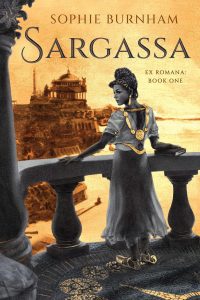Gary K. Wolfe Reviews The Escapement by Lavie Tidhar
 The Escapement, Lavie Tidhar (Tachyon 978-1-61696-327-9, $16.95, 256pp, tp) September 2021.
The Escapement, Lavie Tidhar (Tachyon 978-1-61696-327-9, $16.95, 256pp, tp) September 2021.
In the most exuberant sense of the word, Lavie Tidhar is something of a literary magpie, borrowing from – and celebrating – a dizzying variety of narrative traditions. His previous novel, By Force Alone, enlisted everything from Macbeth to Roadside Picnic in the service of radically reinventing Arthurian legends. The Escapement is if anything even more radical. In a brief afterword, Tidhar cites sources as unusual as Dr. Seuss, Gilgamesh, Greek mythology, a Hebrew fairy tale, and even John Clute’s theory of horror (in The Darkening Garden). Many readers are likely to suspect that Stephen King’s The Dark Tower also belongs on the list, given the vaguely Western-like setting called the Escapement and the central characters known only as The Stranger and The Kid. But Tidhar’s cultural palimpsest includes far more than literary sources. As with King, Sergio Leone westerns loom large in the background, but so do silent film comedies, classic Surrealist images (Dali’s melting clocks, Oppenheim’s fur-covered teacup), Tarot decks, ancient novelty songs like “The Big Rock Candy Mountain”, and most of all the weird pop-horror mythology of clowns, circuses, aerialists, and mimes. Even the serial killer John Wayne Gacy makes an appearance, in the guise of the monstrous Pogo the Clown (the name he actually used in his charitable performances).
As with A Man Lies Dreaming, probably his boldest and best earlier novel, Tidhar frames and grounds his more fantastical inventions in a tale of real human suffering. In that novel, an improbable noir alternate history featuring Hitler as a failing private eye in 1939 London may all be the dream of a Jewish writer in Auschwitz. The Escapement opens with, and periodically returns to, an unnamed man tending to his apparently dying son in a grimly sterile modern hospital. In the phantasmagorical world of the Escapement, he becomes The Stranger, who is on a quest to find something called the Flower of Heartbeat or the Ur-Shanabi, but who is faced by endless distractions and adventures. After he discovers a group of slaughtered clowns (“this is clown country,” we’re reminded) and sets out to find the outlaws who did it, he finds himself allied with an equally enigmatic figure called The Kid and a rather glamorous piano-playing bounty hunter named Temperanza. Later they meet up with a variety of colorful characters such as tinkerers, a tough war veteran, an engineer, a band of train-robbing aerialists, a Conjurer, and a preacher, each with their own tales and obsessions. Aided by one of the more useful and coherent maps I’ve seen in a recent fantasy novel, we can follow their progress through a dangerous town called Kellysburg, into a region called the Thickening (borrowed from Clute’s four-part structure for horror tales) toward Jericho, and beyond, past a giant hole in the ground, toward the Mountains of Darkness – all while the nameless man paces the white corridors of his child’s hospital, seeking reasons for hope.
Providing an apocalyptic background to all this is an ongoing war among gods called the Titanomachia, drawn from the Greek myth, which may account for the unpredictable shifts in time and space that sometimes disrupt the Escapement, and may have something to do with the recurring “symbol storms” that deposit everything from ankhs and punctuation marks to those Surrealist objects mentioned earlier. There are moments when The Escapement itself feels like such a storm, furiously inventive and wildly eclectic, with radical shifts in tone to match. One page may read like a Keystone Kops scenario – “The man on the unicycle shot forward, hit a trampoline, bounced up into a full aerial cartwheel, and landed improbably on his face in a custard pie that had been lying there” – followed a few pages later by “In all this world only the boy was still and unchanged. The machines monitored his heart rate and his blood pressure, fed him liquids, evacuated waste.” As with A Man Lies Dreaming, these “real-world” passages collectively amount to only a fragment of the novel, but the resonance they create can be stunning. Among the most visual and even cinematic of Tidhar’s novels (Chaplin and Fellini come to mind, as well as Leone and maybe even Jodorowski), it’s also, in the end, a surprisingly touching reminder of how such quests can begin in heartbreak.
Gary K. Wolfe is Emeritus Professor of Humanities at Roosevelt University and a reviewer for Locus magazine since 1991. His reviews have been collected in Soundings (BSFA Award 2006; Hugo nominee), Bearings (Hugo nominee 2011), and Sightings (2011), and his Evaporating Genres: Essays on Fantastic Literature (Wesleyan) received the Locus Award in 2012. Earlier books include The Known and the Unknown: The Iconography of Science Fiction (Eaton Award, 1981), Harlan Ellison: The Edge of Forever (with Ellen Weil, 2002), and David Lindsay (1982). For the Library of America, he edited American Science Fiction: Nine Classic Novels of the 1950s in 2012, with a similar set for the 1960s forthcoming. He has received the Pilgrim Award from the Science Fiction Research Association, the Distinguished Scholarship Award from the International Association for the Fantastic in the Arts, and a Special World Fantasy Award for criticism. His 24-lecture series How Great Science Fiction Works appeared from The Great Courses in 2016. He has received six Hugo nominations, two for his reviews collections and four for The Coode Street Podcast, which he has co-hosted with Jonathan Strahan for more than 300 episodes. He lives in Chicago.
This review and more like it in the August 2021 issue of Locus.
 While you are here, please take a moment to support Locus with a one-time or recurring donation. We rely on reader donations to keep the magazine and site going, and would like to keep the site paywall free, but WE NEED YOUR FINANCIAL SUPPORT to continue quality coverage of the science fiction and fantasy field.
While you are here, please take a moment to support Locus with a one-time or recurring donation. We rely on reader donations to keep the magazine and site going, and would like to keep the site paywall free, but WE NEED YOUR FINANCIAL SUPPORT to continue quality coverage of the science fiction and fantasy field.
©Locus Magazine. Copyrighted material may not be republished without permission of LSFF.








